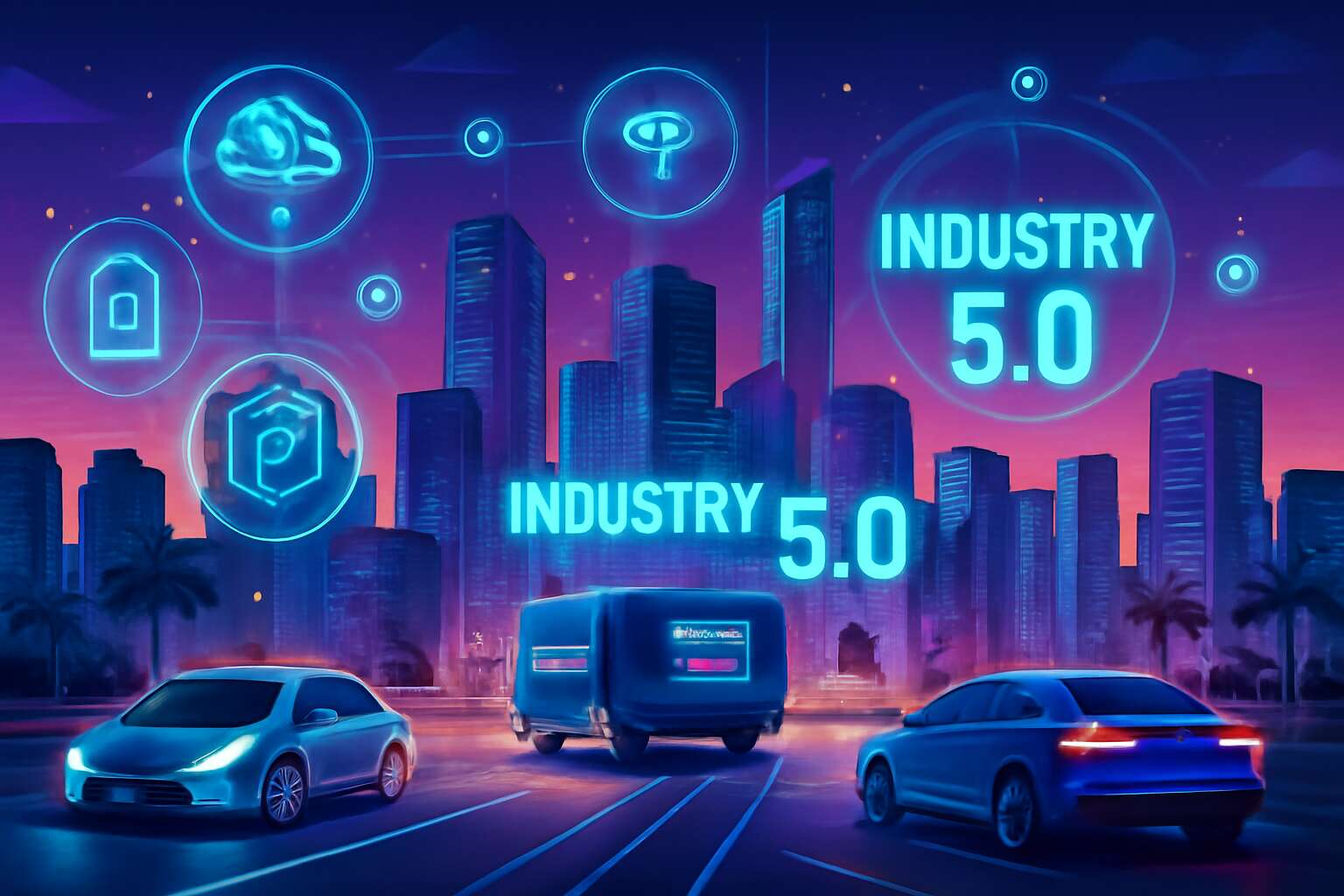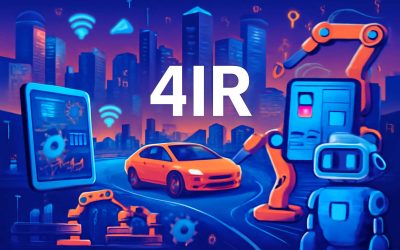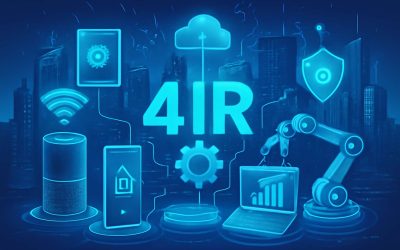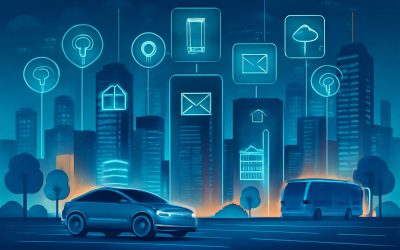Understanding the Fourth Industrial Revolution (4IR)
Definition and Overview
The Fourth Industrial Revolution (4IR) marks a seismic shift in how industries and societies operate, driven by the fusion of digital, physical, and biological worlds. It’s a transformation that transcends mere technological upgrades—it’s a fundamental reordering of the way we live, work, and connect. Unlike previous waves of industrial change, 4IR is characterized by breakthroughs in artificial intelligence, robotics, and the Internet of Things, which are redefining productivity and innovation across South Africa.
Understanding the 4IR involves recognizing that this new era isn’t just about automation; it’s about creating smarter systems that adapt and evolve. As we stand on the cusp of this change, a new frontier emerges—one that blends cutting-edge technology with human ingenuity. The progression from 4IR to 5IR is inevitable, with 5IR emphasizing human-centric innovation and sustainable development. This natural evolution promises to elevate our economy and society to unprecedented heights.
Core Technologies
Understanding the core technologies behind the 4IR unlocks a world of possibilities for South Africa’s future. This new era is driven by innovations that blend digital intelligence with physical realities, creating a fertile ground for growth and development. At the heart of 4IR are breakthroughs in artificial intelligence, robotics, and the Internet of Things—each transforming industries and everyday life alike.
Artificial intelligence (AI) enables machines to learn and adapt, fostering smarter decision-making across sectors. Robotics, with its increasing sophistication, is revolutionizing manufacturing, agriculture, and healthcare, making processes faster and more precise. Meanwhile, the Internet of Things (IoT) connects devices seamlessly, allowing data to flow effortlessly between systems—crucial for building interconnected communities and industries.
To better grasp these innovations, consider this list of core 4IR technologies:
- Artificial Intelligence (AI)
- Robotics and automation
- Internet of Things (IoT)
- Big Data analytics
- blockchain technology
These technological pillars are not just abstract concepts—they are the backbone of a transformative wave that is reshaping South Africa’s economic landscape. As we navigate this complex terrain, it becomes clear that 4IR and 5IR are not just about machines and software, but about harnessing human ingenuity to create a more inclusive, innovative future. The evolution from 4IR to 5IR emphasizes the importance of sustainable development and human-centric solutions, ensuring progress benefits everyone—rural communities included!
Impact on Industries
The dawn of the 4IR heralds a profound metamorphosis, an intricate dance where technology weaves seamlessly into the fabric of industry. In South Africa, this revolution is not merely a whisper but a resounding call to transform entire sectors—agriculture, manufacturing, and logistics—into vibrant ecosystems of innovation. The ripple effect of 4IR and 5IR is felt deeply, reshaping how enterprises operate and how communities thrive.
Industries are awakening to the potential of these technological upheavals, embracing breakthrough innovations that redefine productivity and efficiency. For instance, in agriculture, precision farming powered by IoT sensors and AI-driven analytics cultivates crops with unprecedented accuracy, conserving resources while boosting yields. In manufacturing, robotics and automation accelerate production lines, making them more agile and responsive to market demands. The integration of blockchain technology ensures transparency and security, fostering trust in supply chains across the nation.
- Intelligent data systems generate insights that inform strategic decisions, turning raw information into a competitive edge.
- Connected devices, united by IoT, create interconnected communities where data flows effortlessly, enabling smarter urban planning and resource management.
As South Africa navigates this complex terrain, it’s clear that the evolution from 4IR to 5IR is about more than technological advancements—it’s about harnessing human ingenuity to craft inclusive, sustainable futures. The impact on industries is undeniable; it breathes new life into traditional sectors and sparks a renaissance of innovation that promises to elevate the nation into a new epoch of prosperity.
Key Benefits and Challenges
The Fourth Industrial Revolution (4IR) is often hailed as the dawn of a new era, but let’s be honest — it’s also a rollercoaster ride with its fair share of twists and turns. While the promise of smarter cities, autonomous vehicles, and AI-driven industries dazzles, the journey isn’t without its hurdles. One of the key benefits of 4IR and 5IR is the sheer increase in efficiency. Businesses can streamline operations, reduce waste, and harness intelligent data systems to make smarter decisions faster than ever before.
However, embracing these technological marvels isn’t all rainbows and quantum leaps. Challenges like digital inequality, cybersecurity threats, and the need for upskilling the workforce lurk in the shadows. For South Africa, navigating the 4IR and 5IR landscape means balancing innovation with inclusion. The transformation demands not only cutting-edge technology but also a human touch—an understanding that progress must serve all communities, not just the tech-savvy elite.
To put it plainly, the evolution from 4IR to 5IR is a complex dance—one that involves juggling rapid technological advances with societal needs. Success hinges on addressing these challenges while capitalizing on opportunities like connected devices and blockchain to build resilient, future-ready industries. Because if there’s one thing certain about 4IR and 5IR, it’s that ignoring them isn’t an option—South Africa’s future depends on it.
Exploring the Fifth Industrial Revolution (5IR)
Definition and Characteristics
As the world spins its future anew, the Fifth Industrial Revolution (5IR) beckons with a promise — a symphony where technology and human ingenuity intertwine seamlessly. Unlike its predecessor, 4IR, which revolutionized automation and data-driven innovation, 5IR elevates this dance, emphasizing sustainable growth and human-centered progress. It’s a realm where artificial intelligence, blockchain, and renewable energy forge a new paradigm, creating a landscape that is as imaginative as it is pragmatic.
What truly sets 5IR apart is its focus on harmony — balancing technological advancements with societal values. It challenges us to rethink how industries operate, fostering a future where economic development coexists with environmental stewardship. This shift isn’t just about faster, smarter solutions but about crafting a world where innovation uplifts communities and preserves the planet for generations to come. South Africa, with its unique blend of challenges and opportunities, stands at the cusp of this transformative era, poised to harness the full potential of 5IR’s innovative wave.
Emerging Technologies
As South Africa stands on the cusp of a technological renaissance, exploring the emerging technologies of the Fifth Industrial Revolution (5IR) reveals a landscape bursting with potential. Unlike the 4IR, which primarily emphasized automation and data-driven innovations, 5IR introduces a holistic approach—merging artificial intelligence, blockchain, and renewable energy into a symphony of sustainable development. It’s an era where technological prowess is no longer an end but a means to fostering societal well-being.
What makes 5IR particularly captivating is its focus on human-centric progress. Instead of merely enhancing productivity, it seeks to elevate communities, ensuring that innovation benefits everyone. The integration of emerging technologies such as smart grids, IoT, and biotech opens new avenues for South Africa’s industries to evolve, emphasizing not just growth but responsible growth. Here are a few key developments shaping this new chapter:
- Advanced AI-driven solutions tailored to address local challenges.
- Decentralized blockchain networks that enhance transparency and security.
- Renewable energy innovations aiming to reduce the nation’s carbon footprint.
As the world pivots from 4IR to 5IR, the conversation shifts from what technology can do to how it can serve humanity best. South Africa, with its unique social fabric and resource base, is uniquely poised to harness these emerging technologies and craft a future that is both resilient and inclusive — a true testament to the promise of 5IR.
Transformative Changes
As South Africa navigates the dawn of the Fifth Industrial Revolution (5IR), a profound transformation is taking shape—one that promises to redefine societal progress. Unlike the 4IR, which laid the groundwork through automation and data-driven innovations, 5IR offers a more human-centered vision, integrating emerging technologies such as blockchain, renewable energy, and AI into a tapestry of sustainable development.
This new era emphasizes responsible growth—where technological advancements serve not just economic ends but also societal well-being. With innovations like smart grids, IoT, and biotech, South Africa stands to forge a future that balances resilience with inclusivity. It’s a delicate dance, where progress is measured not merely by productivity but by the upliftment of communities and the environment.
- Advanced AI solutions tailored to local challenges
- Decentralized blockchain networks that bolster transparency
- Renewable energy innovations aimed at reducing carbon footprints
What makes 5IR truly captivating is its potential to elevate every facet of life—transforming industries and creating opportunities rooted in sustainability. South Africa’s unique social fabric and abundant resources position it perfectly to harness these emerging technologies, crafting a resilient, inclusive future that embodies the very spirit of 5IR’s promise.
Advantages and Concerns
As South Africa stands on the cusp of a new era, the advantages of the Fifth Industrial Revolution (5IR) become increasingly apparent. This transformative wave promises to elevate societal well-being through responsible innovation, fostering a balance between technological progress and human-centric values. Unlike the 4IR, which primarily focused on automation and data mastery, 5IR emphasizes inclusive growth and sustainable development, making it a compelling vision for the nation’s future.
However, alongside these promising prospects come significant concerns. The rapid adoption of advanced AI solutions tailored to local challenges could widen socio-economic gaps if not managed thoughtfully. Moreover, the integration of blockchain and renewable energy technologies raises questions about infrastructure readiness and long-term environmental impacts. Navigating these complexities requires strategic foresight—balancing innovation with societal resilience. As South Africa embraces the potential of 4IR and 5IR, understanding both the opportunities and risks is crucial to forging a truly inclusive and sustainable future.
Comparing 4IR and 5IR
Technological Differences
The evolution from 4IR to 5IR marks a pivotal juncture in our technological odyssey—an inflection point where the digital and human realms intertwine with unprecedented intimacy. While 4IR, or the Fourth Industrial Revolution, laid the groundwork by integrating automation, big data, and IoT, 5IR emerges as an epoch driven by human-centric innovation and sustainable development. It’s not merely about smarter machines but about fostering symbiotic relationships that amplify human ingenuity.
In comparing 4IR and 5IR, the distinctions become profoundly clear. 4IR harnesses cutting-edge technologies like artificial intelligence and robotics, often emphasizing efficiency and scalability. Conversely, 5IR pushes this boundary further by embedding ethics, societal impact, and environmental consciousness into technological deployment. This shift transforms industries—agriculture, manufacturing, and healthcare—by prioritizing not only productivity but also resilience and social equity.
- Focus on human values and societal well-being
- Integration of sustainable practices with technological advancements
- Enhanced collaboration between humans and machines for creative problem-solving
Innovation Pace
The pace of innovation between 4IR and 5IR reveals a fascinating evolution that shapes our societal landscape. While 4IR has accelerated technological adoption at an unprecedented rate—integrating AI, IoT, and automation to boost efficiency—the transition into 5IR marks a deliberate shift toward human-centric development. This new era emphasizes sustainable practices and societal well-being, ensuring technology serves the broader community, not just economic gain.
In terms of innovation speed, 4IR’s rapid deployment often focused on scalability and technical prowess. However, 5IR introduces a more measured, thoughtful rhythm—where collaboration between humans and machines becomes more intuitive, fostering creative problem-solving. The transition isn’t merely about faster tech but about aligning technological progress with human values, making the pace of innovation more deliberate and impactful.
Economic and Social Impact
The economic and social ripple effects of 4IR and 5IR are profound, shaping the fabric of society in ways both visible and subtle. While 4IR ignited a technological revolution—propelling industries with AI, IoT, and automation—its focus was largely on efficiency and scalability. The transition into 5IR, however, signals a shift towards a more holistic approach. This new era emphasizes sustainable growth, societal well-being, and the integration of human-centered design into technological advancement.
In terms of social impact, 4IR transformed workplaces and daily life, often creating a divide between those who adapt quickly and those left behind. Conversely, 5IR fosters inclusivity by prioritizing community-centric innovations and ethical considerations. This shift encourages collaboration between humans and machines, making the innovation process more deliberate and impactful.
- Enhanced social cohesion
- Greater emphasis on sustainability
These changes aim to balance economic gains with societal progress, ensuring technology benefits everyone, not just a select few. The contrast between 4IR and 5IR’s influence underscores the importance of aligning technological evolution with human values and societal needs.”
Implementation and Adoption Challenges
The journey from 4IR to 5IR is not merely a technological evolution; it’s a profound shift in how societies embrace innovation. While 4IR implementation focused largely on automating processes and enhancing efficiency, the adoption of 5IR presents a more complex, human-centric challenge. The transition demands not only technological readiness but also societal acceptance and ethical alignment, especially in diverse contexts like South Africa.
Implementing 4IR was often straightforward—industrial sectors rapidly integrated AI, IoT, and automation to boost productivity. However, 5IR calls for a delicate balance: fostering inclusivity while advancing sustainable growth. Challenges include overcoming digital divides, ensuring equitable access, and restructuring education systems to prepare a future workforce adaptable to these rapid changes.
- Infrastructure development
- Policy adaptation
- Addressing societal disparities
Adopting 5IR technology is a nuanced dance, requiring patience and vision. While the pace of innovation accelerates, the real challenge lies in aligning these advancements with societal values—creating a future where technological progress uplifts everyone, not just a privileged few.
The Role of Digital Transformation in 4IR and 5IR
Digital Infrastructure
Digital transformation is the backbone of the 4IR and 5IR revolutions, reshaping how economies operate and societies function. In South Africa, this shift is not just about adopting new tools but fundamentally rethinking infrastructure to support hyper-connectivity and real-time data flow. The integration of advanced digital infrastructure—such as cloud computing, IoT, and AI—drives innovation and enhances efficiency across sectors. It’s fascinating to see how these technological strides facilitate smarter logistics, improved healthcare delivery, and more resilient energy systems.
Crucially, the role of digital infrastructure in 4IR and 5IR extends beyond technology. It influences policy frameworks, workforce skills, and social inclusion. For instance, the deployment of digital platforms accelerates financial inclusion by bridging gaps in rural communities. As South Africa navigates this terrain, it’s evident that the success of 4IR and 5IR hinges on robust infrastructure that can adapt to rapid technological advancements. To grasp the full scope, consider the following factors that underpin this digital transformation:
- Investment in high-speed broadband networks
- Development of secure data centers and cloud services
- Implementation of interoperable digital platforms
Ultimately, the digital infrastructure supporting 4IR and 5IR is shaping a future where technology becomes more accessible and integrated into everyday life, with profound economic and social implications for South Africa.
Smart Technologies
Digital transformation is the heartbeat of the 4IR and 5IR revolutions, breathing new life into industries and society alike. It’s not just about deploying the latest gadgets; it’s about weaving a seamless digital fabric that enhances efficiency, fosters innovation, and unlocks new possibilities. Smart technologies like IoT, AI, and cloud computing act as catalysts, transforming traditional workflows into intelligent, interconnected ecosystems. In South Africa, this shift fuels a wave of opportunities—from smarter agriculture to digital health solutions—each driven by the relentless march of 4IR and 5IR.
At the core of this transformation lies a commitment to building resilient digital infrastructure. This includes:
- High-speed broadband networks connecting rural and urban areas
- Secure data centers supporting real-time data processing
- Interoperable digital platforms fostering collaboration across sectors
As South Africa navigates the maze of technological evolution, embracing digital transformation in 4IR and 5IR is essential for unlocking economic growth and social inclusion. It’s an exciting era where imagination meets innovation, shaping a future that’s more connected than ever before!
Data-Driven Decision Making
In the vibrant tapestry of South Africa’s digital evolution, data-driven decision making has become the secret weapon powering the 4IR and 5IR revolutions. As industries embrace this wave of transformation, harnessing data isn’t just a convenience—it’s the backbone of strategic growth and innovation. Imagine a farmer in Limpopo utilizing real-time weather data and soil sensors to optimize crop yields—this is the tangible magic of digital transformation in action.
By leveraging advanced analytics, artificial intelligence, and IoT, businesses can unlock insights that drive smarter, more responsive decisions. This shift from intuition-based to data-centric strategies enables organizations to anticipate market trends, reduce risks, and enhance operational agility. In South Africa, sectors such as mining, agriculture, and healthcare are already reaping the benefits of this data revolution, setting the stage for unprecedented economic growth.
For a seamless transition, many enterprises are adopting digital platforms that facilitate interconnected workflows—streamlining communication and fostering collaboration across sectors. As the 4IR and 5IR continue to unfold, data-driven decision making will remain the compass guiding South Africa’s journey into a more innovative, resilient future.
Cybersecurity Concerns
As South Africa accelerates its journey into the 4IR and 5IR, digital transformation has become both a catalyst and a challenge—especially in the realm of cybersecurity. The rapid adoption of interconnected technologies, from IoT devices to cloud platforms, magnifies vulnerabilities that cybercriminals are eager to exploit. The stakes are high; a single breach can compromise sensitive data, cripple vital services, or erode consumer trust in an instant.
In this evolving landscape, safeguarding digital assets requires more than traditional security measures. Organizations must develop resilient cybersecurity frameworks that anticipate emerging threats unique to 4IR and 5IR environments. This includes implementing advanced encryption, real-time threat detection, and continuous monitoring, all while fostering a culture of digital vigilance across sectors.
To navigate these complexities, some experts recommend adopting a layered security approach:
- Regular vulnerability assessments
- Enhanced access controls
- Employee cybersecurity training
As South Africa’s industries embrace the transformative power of 4IR and 5IR, balancing innovation with robust cybersecurity measures will be essential to secure a resilient future—one where the promise of digital progress isn’t overshadowed by the perils of cyber threats.
Future Outlook and Trends
Predicted Developments in 4IR
The horizon of the 4IR and 5IR is bursting with promise, yet it also beckons us to prepare for profound shifts. As technology matures, the pace of innovation suggests a future where industries evolve at an unprecedented rate, transforming daily lives and economic landscapes alike. South Africa, with its unique blend of rural resilience and urban dynamism, stands at a pivotal crossroads—poised to harness these emerging technological waves.
Predicted developments in 4IR and 5IR point towards increasingly intelligent automation, augmented by breakthroughs in artificial intelligence and edge computing. These advancements will likely accelerate the digitization of sectors such as agriculture, healthcare, and manufacturing, fostering smarter, more sustainable communities. For example, precision farming—enabled by IoT sensors—will become more widespread, empowering farmers in rural areas to maximize yields and reduce resource waste.
Looking ahead, the integration of 4IR and 5IR technologies will be shaped by several trends, including a focus on digital inclusion and infrastructure development. As connectivity deepens, innovative solutions will emerge to bridge the urban-rural divide, ensuring that even the most remote communities benefit from technological progress. This unfolding landscape promises not just economic growth but a more equitable, resilient society that values human ingenuity and cultural richness alike.
Emerging Trends in 5IR
As the horizon of 4IR and 5IR unfolds, the future promises a tapestry woven with innovation, resilience, and human ingenuity. Emerging trends point toward a seamless fusion of digital and physical realms, where intelligent automation and augmented reality redefine the way we live and work. In South Africa, this evolution offers a rare opportunity to bridge divides and elevate communities through technology that is both inclusive and transformative.
One of the most compelling developments is the rise of smart technologies that harness data-driven decision-making. These advancements will empower local industries—especially agriculture and manufacturing—to operate more sustainably and efficiently. The push for digital inclusion is palpable, with infrastructure development playing a pivotal role. As connectivity deepens, remote communities will increasingly participate in the digital economy, fostering a sense of unity and shared progress.
- Enhanced connectivity through 5G networks
- Integration of AI-powered solutions in everyday life
- Growing emphasis on sustainable technology to combat climate change
In essence, the emerging trends in 4IR and 5IR herald a new era—one marked by unprecedented opportunities and profound societal shifts. South Africa’s unique landscape, blending rural resilience with urban dynamism, is poised to harness these transformative waves, shaping a future where technology and humanity walk hand in hand towards a brighter horizon.
Potential Disruptions
The future of 4IR and 5IR holds a profound promise—one that challenges us to reimagine what is possible for South Africa’s socio-economic landscape. As these technological epochs unfold, potential disruptions loom on the horizon, capable of reshaping industries and societal structures in ways both exhilarating and unsettling. While innovation accelerates, so too does the risk of widening the digital divide, threatening to leave behind those unprepared for rapid change.
Yet, amidst these uncertainties, opportunities abound. The integration of advanced connectivity, such as 5G, promises to catalyze rural inclusion and boost local entrepreneurship. At the same time, the rise of AI-driven automation could redefine employment, pushing society to confront questions about human purpose and resilience. The delicate balance between technological progress and societal stability will be the defining challenge of this new era.
- Disruptive technologies may threaten traditional job sectors, demanding a reevaluation of workforce skills.
- Cybersecurity vulnerabilities could emerge as digital dependence deepens, requiring vigilant safeguards.
- Legal and ethical frameworks will need to evolve rapidly, ensuring that innovations serve humanity without infringing on fundamental rights.
In this intricate dance of progress, the true potential of 4IR and 5IR hinges on our collective ability to adapt with foresight and moral clarity. South Africa’s unique socio-cultural fabric will either be a catalyst for inclusive innovation or a battleground for inequality, depending on how these transformative waves are navigated. The horizon beckons—full of promise, peril, and the inexorable call to shape a future that honors both human dignity and technological advancement.
Preparing for the Next Wave of Industrial Innovation
As South Africa stands on the cusp of an unprecedented technological renaissance, the future outlook for 4IR and 5IR is both tantalizing and daunting. The next wave of industrial innovation promises to redefine not only economic paradigms but also societal values, demanding a nuanced understanding of emerging trends. With the rapid evolution of these transformative epochs, anticipation is high that we will witness a surge in smart technologies and data-driven decision making, reshaping how industries operate and communities connect.
Forecasts indicate that the trajectory of 4IR and 5IR will be characterized by a blend of seamless connectivity and heightened automation. This convergence is expected to accelerate rural inclusion, fostering local entrepreneurship and narrowing inequalities. Yet, alongside these promising developments, there lies a pressing need for robust cybersecurity measures and adaptive legal frameworks that can keep pace with innovation. The challenge is to harness these breakthroughs responsibly while safeguarding societal integrity.
- Exponential growth in digital infrastructure
- Enhanced integration of AI and IoT for smarter cities
- Increased focus on sustainable and ethically aligned technologies
Ultimately, the journey into this new era hinges on our collective capacity to anticipate disruptors and leverage opportunities, ensuring that South Africa’s unique socio-cultural fabric is a catalyst for inclusive, resilient progress. As the horizon expands, so too does the potential for profound transformation driven by 4IR and 5IR—an era where innovation and human dignity must walk hand in hand.




0 Comments